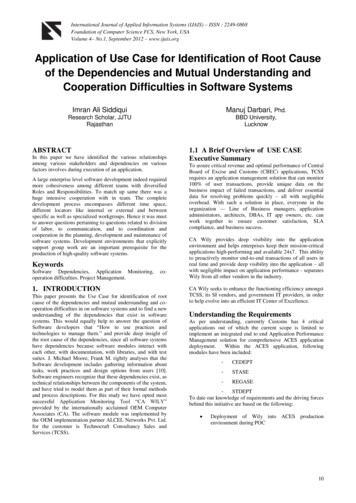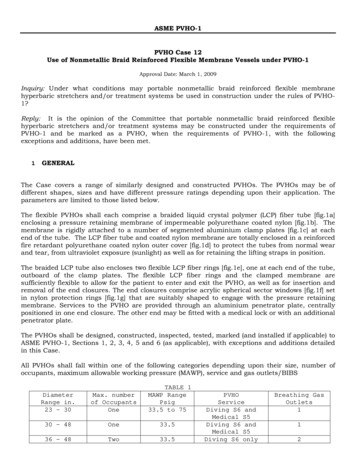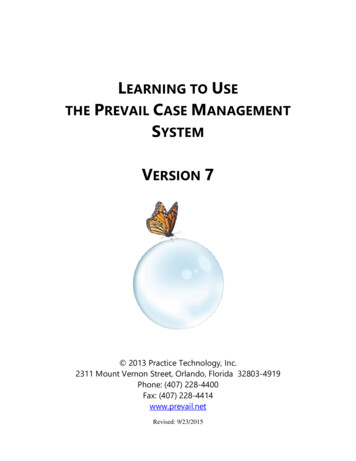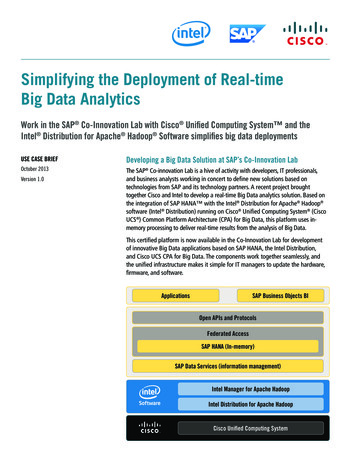
Transcription
International Journal of Applied Information Systems (IJAIS) – ISSN : 2249-0868Foundation of Computer Science FCS, New York, USAVolume 4– No.1, September 2012 – www.ijais.orgApplication of Use Case for Identification of Root Causeof the Dependencies and Mutual Understanding andCooperation Difficulties in Software SystemsImran Ali SiddiquiManuj Darbari, Phd.Research Scholar, JJTURajasthanBBD University,LucknowABSTRACTIn this paper we have identified the various relationshipsamong various stakeholders and dependencies on variousfactors involves during execution of an application.A large enterprise level software development indeed requiredmore cohesiveness among different teams with diversifiedRoles and Responsibilities. To match up same there was ahuge intensive cooperation with in team. The completedevelopment process encompasses different time space,different locators like internal or external and betweenspecific as well as specialized workgroups. Hence it was mustto answer questions pertaining to questions related to divisionof labor, to communication, and to coordination andcooperation in the planning, development and maintenance ofsoftware systems. Development environments that explicitlysupport group work are an important prerequisite for theproduction of high-quality software systems.KeywordsSoftware Dependencies, Application Monitoring,operation difficulties. Project Management.co-1. INTRODUCTIONThis paper presents the Use Case for identification of rootcause of the dependencies and mutual understanding and cooperation difficulties in on software systems and to find a newunderstanding of the dependencies that exist in softwaresystems. This would equally help to answer the question ofSoftware developers that ―How to use practices andtechnologies to manage them.‖ and provide deep insight ofthe root cause of the dependencies, since all software systemshave dependencies because software modules interact witheach other, with documentation, with libraries, and with testsuites. J. Michael Moore, Frank M. rightly analyses that theSoftware development includes gathering information abouttasks, work practices and design options from users [10].Software engineers recognize that these dependencies exist, astechnical relationships between the components of the system,and have tried to model them as part of their formal methodsand process descriptions. For this study we have opted mostsuccessful Application Monitoring Tool ―CA WILY‖provided by the internationally acclaimed OEM ComputerAssociates (CA). The software module was implemented bythe OEM implementation partner ALCEL Networks Pvt. Ltd.for the customer is Technocraft Consultancy Sales andServices (TCSS).1.1 A Brief Overview of USE CASEExecutive SummaryTo assure critical revenue and optimal performance of CentralBoard of Excise and Customs (CBEC) applications, TCSSrequires an application management solution that can monitor100% of user transactions, provide unique data on thebusiness impact of failed transactions, and deliver essentialdata for resolving problems quickly – all with negligibleoverhead. With such a solution in place, everyone in theorganization — Line of Business managers, applicationadministrators, architects, DBAs, IT app owners, etc. canwork together to ensure customer satisfaction, SLAcompliance, and business success.CA Wily provides deep visibility into the applicationenvironment and helps enterprises keep their mission-criticalapplications high-performing and available 24x7. This abilityto proactively monitor end-to-end transactions of all users inreal time and provide deep visibility into the application – allwith negligible impact on application performance - separatesWily from all other vendors in the industry.CA Wily seeks to enhance the functioning efficiency amongstTCSS, its SI vendors, and government IT providers, in orderto help evolve into an efficient IT Center of Excellence.Understanding the RequirementsAs per understanding, currently Customs has 4 criticalapplications out of which the current scope is limited toimplement an integrated end to end Application PerformanceManagement solution for comprehensive ACES applicationdeployment.Within the ACES application, followingmodules have been included:-CEDEPT-STASE-REGASESTDEPTTo date our knowledge of requirements and the driving forcesbehind this initiative are based on the following: Deployment of Wily into ACES productionenvironment during POC10
International Journal of Applied Information Systems (IJAIS) – ISSN : 2249-0868Foundation of Computer Science FCS, New York, USAVolume 4– No.1, September 2012 – www.ijais.org Analytical review of performance bottlenecksduring peak periods Experience discussing withACES on various IT initiatives.business process level to the transaction Component level foreach individual user, it enables you to calculate the impact ofperformance incidents and prioritize responses To monitor and manage the following ACESmodule consisting of CEDEPT STASE REGASE STDEPTCA Wily CEM is a hardware appliance and as such has norequirement for an underlying operating system, database, orother 3rd party software. The only client software requiredis web browser. The appliance ships with sufficient storageto maintain historical data. The data gathered can beexported to any relational database you choose, but there areno requirements for database licensing to support the CAWily solution. All of the above on 42 cores (21 CPUs) across 2clustered instancesApplication Performance/ WebManagementCA Wily is an application management solution that canmonitor 100% of end-user transactions happening in a TCSS,provide unique data on the impact of failed transactions, anddeliver essential data for resolving problems quickly – allwith negligible overhead. With such a solution in place,everyone in TCSS —application owners, network owners,departments, etc. can work together to ensure SLAcompliance and end-user satisfaction.CA Wily provides deep visibility into the applicationenvironment and helps TCSS keep their mission-criticalapplications high-performing and available 24x7. This abilityto proactively monitor end-to-end transactions of all users inreal time and provide deep visibility into the application – allwith negligible impact on application performance - separatesWily from all other vendors in the industry.CA‘s Wily Technology offers the only comprehensivesoftware and services solution specifically designed to ensureeffective Customer Success Management (CSM) by offeringunparalleled visibility into customer transactions and webinfrastructure performance.CA Wily Customer Experience Manager (CEM) providesreal-time views and proactive alerts that enable you toimmediately respond to the online experience of eachapplication end user, detect transaction problems as theyhappen, and ensure transaction integrity.CEM monitors every transaction in real time, analyzing theperformance and quality of web-enabled business processes.When problems with real or synthetic transactions occur,CEM provides detailed analysis on the scope, severity, andimpact of the transaction defects. CEM enables you toidentify, prioritize and resolve defective transactions —often before they impact users — through real-time visibilityinto transactions. By measuring performance from theTIM (Transaction Impact Monitor): The TIM is nonintrusive appliance that resides in the data centre, connectedto a mirrored switch port or a network tap. The TIMpassively listens to all network traffic and analyzes only thetraffic of interest. Using patent-pending software, itassembles data packets into unique business transactions.TIM applies business rules to detect customer-impactingdefects and anomalies, and reports real time and historicalinformation about customers and transactions to a centralrepository.The TIM‘s primary functions are to: Observe a packet stream. CEM uses a copy of thenetwork traffic using a span or mirror portresulting in zero network utilization. Identify transactions and users Monitor transactions for defects and intervalstatistics regarding behavioral characteristics liketime, size and throughput. Upload the defects and interval statistics to the(TESS)Transaction Event and Statistics Server (TESS): TheTESS runs the Wily CEM Software Modules. The TESScommunicates with one or more TIMs and is accessedthrough any browser. It receives real time alerts (events)and performance and quality statistics from one or moreTIMs, allowing IT personnel to collect metrics centrallyfrom various applications. The TESS is what allows ITteams to analyze, aggregate, and present real time andhistorical data, creating views, reports, and scorecardsfor incident resolution, continuous improvement, andexecutive reporting. The TESS is a combination ofbackground processes, application logic, an SQLdatabase and a Web serverThe architecture of the CEM has been designed to scaleas your environment grows. The architecture providesfor scalable growth through the addition of TransactionImpact Monitors as needed. Multiple TIMs can be usedto report to one TESS. TIMs can be distributed acrossdifferent data centers.11
International Journal of Applied Information Systems (IJAIS) – ISSN : 2249-0868Foundation of Computer Science FCS, New York, USAVolume 4– No.1, September 2012 – www.ijais.orgTable 1: Summary Features of CA Wily24x7 ApplicationMonitoringIncident Detectionand NotificationRapid TriageRoot f,applicationadministrators, IT application ownersand the business units they serve allneed24x7accesstoreal-timeinformation about the health andavailability of production webapplications.When problems occur, operations andapplication support personnel need toknow at the soonest possible moment,before end-users are affected. Thisrequires a proactive detection andnotification system.Once a problem has been detected,application support personnel need toquickly and reliably determine whereto assign the fix. Effective triageeliminates the chaos of the blamegame and finger pointing.Javadevelopersandsystemadministrators need timely, accurateinformation about the source ofperformance problems so that theseissues can be resolved with minimalimpact on IT resources.Historical data capture gives IT andthe Business Units it serves theinformation they need to effectivelymanage and maintain service levels. Italso allows capacity planners toanalyze trends over time and plan forfuture needs.CA Wily Introscope is an application management solutionthat helps TCSS to keep the mission-critical web-based J2EEand .NET applications high performing and available 24x7. Itcombines proven technology, scalability and ease-of-use tooffer the very best means for monitoring and managingcomplex, composite applications. It ensures that applicationsare successfully achieving required SLAs and otherperformance goals. Introscope is the cornerstone of acomprehensive collaborative application managementsolution that helps TCSS increase application resiliency,minimize the impact of application performance issues andimprove total cost of ownership.Introscope agents collect performance metrics from thevarious components inside the running Java / J2EEapplication, the application server and performance andavailability data from the surrounding computingenvironment. The agents then report these metrics to theEnterprise Manager. No change to your source code isrequired. Out of the box (i.e. no configuration), Introscopeagent will monitor EJBs: (Entity, Session, and Message-driven asapplicable) JSPs Servlets JDBC JNDI Network Sockets RMI XML JTA JMS CORBA UDP File I/O Socket I/O CPU ThreadsIn addition, GC Heap Bytes in Use, GC Heap Bytes Total,Java Version, Launch Timestamp, VM Vendor, IP Address,Operating System, and Wall clock Time are all monitored―outside‖ the Java VM.The Introscope Enterprise Manager acts as the centralrepository of all Introscope performance metrics. It receivesperformance metrics from one or more Introscope Agents,allowing users to collect metrics centrally from manyapplications, application servers and supporting systems.Introscope includes out-of-the-box reports for applicationperformance analysis, capacity planning and Service LevelAgreement administration, which make it easier to trackapplication performance over time and plan for future growth.Introscope provides the breakdown of individual usertransactions displaying precisely what exception was thrownand where the exception was thrown from (essentially the callstack). When viewing a faulty transaction in TransactionTracer, one can easily identify precisely where the exceptionis being generated from.DEPLOYMENT ARCHITECTUREFig 1: Deployment Architecture12
International Journal of Applied Information Systems (IJAIS) – ISSN : 2249-0868Foundation of Computer Science FCS, New York, USAVolume 4– No.1, September 2012 – www.ijais.orgSome key benefits for TCSSoProvide visibility into thetransactions, as they happen.oProvide the ability to visualize performance at bothgranular and abstracted levels.oDetect performance threats and alert staff asperformance metrics approach thresholds—not afterthey violate them.oOffer highly customizable reports and dashboards tomeet the needs of diverse users—from operators toapplication owners, database administrators, and theDepartments Heads.oProvide low-level diagnostics that help pinpoint thesource of performance glitches.oRecord and provide historical performance data foranalysis and continuous improvement.integrityofFig 2: Transaction Tracer functionalityIntroscope‘s built-in Transaction Tracer functionalityprovides an excellent facility for just this purpose. Thefollowing screenshots fig01, fig02 and fig03 show a view ofthe transaction. This view can be used to determine if theapplication is making excessive calls to particular methods inthe code. (a.k.a. ‗Death by a thousand paper cuts‘). Byintegrating with the system management procedures,Introscope empowers your IT organization to create aneffective, and necessary, process for detecting and resolvingweb application performance issues. With hyper-linking andcustomizable graphical displays, Introscope‘s easy-to-usedashboards can be tailored for individual users to offer deep,intuitive views of the application infrastructure. Thesedashboards integrate seamlessly with pre-defined operationsprocedures allowing operations personnel to identify andtriage application performance issues regardless of their levelof Java expertise. Additionally, Introscope Console Lensdecreases the time-to-value of Introscope by giving you theoption of using an existing dashboard configuration tomonitor multiple applications.Fig 4 : Investigator2. USE CASE SCOPE OF WORK (SOW)AND THE END DELIVERABLES2.1 OverviewThe CA Wily APM Rapid Implementation methodology isdesigned to deploy CA Wily Introscope and CA Wily CEM inthe TCSS environment to provide 24 x 7 monitoring of webapplications to help detect various performance issues andprovide an opportunity for the TCSS and its Application SI,TCSS to resolve these issues before they affect end-usercustomers (the ―Solution‖).ALCEL Networks Services will work with the TCSS todesign, install, configure and deploy the selected software inaccordance with specific parameters set forth herein (the―Project‖). Industry best Project Management techniqueswere applied like Agile Communication [6]Fig 3: SMCS13
International Journal of Applied Information Systems (IJAIS) – ISSN : 2249-0868Foundation of Computer Science FCS, New York, USAVolume 4– No.1, September 2012 – www.ijais.org2.2 Responsibilities of the partiesThe team performing this Project will consist of (i) ALCELNetworks personnel and (ii) Customer personnel (collectively,the "Project Team"). TCSS and ALCEL Networks are eachresponsible for the performance of their respectiveindependent contractors. Each party agrees to providequalified personnel to perform their responsibilities under thisSOW and to use practical and diligent efforts to maintain thecontinuity of their respective personnel assigned to the Projectand perform the tasks identified as their responsibility in theProject schedule.TCSS and ALCEL Networks will mutually agree upon thetasks to be completed by both parties prior to each ProjectStage and, upon validation of planning, schedule, tasks,specifications and test criteria; any such decisions will not beunreasonably withheld or delayed.Customer acknowledges and agrees to execute the MilestoneAcceptance Form attached as Exhibit 1 upon completion ofthe Project set forth herein.2.3 Project management servicesALCEL Networks will designate a principal point-of-contactto act as the ALCEL Networks project manager for theProject to provide the services below. TCSS agrees todesignate a point-of-contact as the TCSS project manager toassist the ALCEL Networks point-of-contact to fulfill theresponsibilities as set out below.a.b.c.d.Verify expectations, requirements and acceptance criteriawith Customer sponsor and key stakeholdersSelect and schedule TCSS and ALCEL Networkspersonnel to complete the Project tasksFollow ALCEL Networks risk management procedure toidentify, review, manage and escalate as appropriate.Obtain TCSS sign-off on the Milestone AcceptanceForm attached as Exhibit 1. Deliverables will be deemedto be accepted upon TCSS execution of this Form.Stage 1 – Project Setup and Initiation (Week 1)During this Stage, to be conducted remotely, the TCSSALCEL Networks project managers will:a.Validate those prerequisites as identified in the Assumptionsand TCSS.Responsibilities sections are accurate andcomplete.b.Conduct a kickoff meeting call to introduce the Project Teamand stakeholders, communicate the Project scope andrequirements, discuss Project task list and assign ALCELNetworks or TCSS personnel as applicable to the designatedtasks.c. Finalize Project plan with detailed activities and timelinesStage 1 Deliverable: Project task list and planStage 2 – Solution Requirements Definition (Week 2)During Stage 2 the Project Team will verify the business andinformation technology (―IT‖) requirements of the Solution. Apreviously completed High Level Design (―HLD‖) document orappropriate completed questionnaire(s) in which suchrequirements were defined will be used as the basis for thisreview.ALCEL Networks and TCSS will:a.Review and verify the previously completed HLD orquestionnaire(s) which collectively identify:i.Target application(s)ii. Network, servercomponentsandsysteminfrastructureiii. IT and business drivers for the SolutionFor CA Wily Introscope:iv.Application components (e.g., transaction groups,users, application server resources, operation type-e.g., create, delete) to be monitored by CA WilyIntroscope and displayed by CA Wily Introscopedashboardsv.Application performance metrics to be used by CAWily Introscope to monitor the in-scopeapplicationvi.Transaction issues currently experienced (e.g.,performance problems related to time of day andsystem load)2.4 Project approachThis Project will be performed in accordance with ALCELNetworks‘s implementation methodology identified in thestages below (each a ―Stage‖; collectively the ―Stages‖).Each Stage has a predetermined set of tasks and goals.andThe work from the prior Stage will form the basis of the workfor the next Stage. If work from a prior Stage is revisited at alater Stage, this will result in a change to the Project fee andschedule.iv.Project Plan A detailed project plan with timelines will becompiled during the first week of the engagement andsubmitted for acknowledgement.Business processes (e.g., the high level functions inthe application, such as login, search, report) to bemonitored for the in-scope applicationv.Transactionexperiencedvi.Business process reporting requirementsvii.Users and user groups.In performance of this SOW, ALCEL Networks will workwith TCSS to complete the following:For CA Wily CEM:performanceissuescurrently14
In
successful Application Monitoring Tool ―CA WILY‖ provided by the internationally acclaimed OEM Computer Associates (CA). The software module was implemented by the OEM implementation partner ALCEL Networks Pvt. Ltd. for the customer is Technocraft Consultancy Sa











